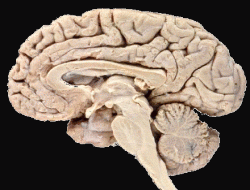July 5, 2011 report
True love acts as a painkiller: study

(Medical Xpress) -- A new study published in the Proceedings of the National Academy of Science reveals that true love acts on areas of the brain responsible for pain and safety and works to minimize pain levels.
The research, led by Naomi Eisenberger from the University of California, looked at 17 women who were currently in long-term relationships. The researchers used MRIs to monitor the women’s brains while administering stinging shocks to their body. The women were asked to look at pictures while receiving the shocks which varied from a picture of their partner, strangers, or stationary objects. The women were then given a 20-point scale to use to rate their pain after each shock.
The pain scores were lower for the women when they were looking at a picture of their partner. Looking then at the MRI scans matching those shocks, the researchers found activity in the brain region associated with pain, but they also discovered activity in the ventromedial prefrontal cortex which is associated with a feeling of safety.
Looking further at the women and the relationships they were in, they found that the longer the women had been in the relationship and the more overall support they received from their partner, the greater the level of activity in the ventromedial prefrontal cortex, or VMPFC, was demonstrated.
The VMPFC is capable of inhibiting other pathways in the brain responsible for fear and anxiety, so this level of safety the women feel in their relationship helps to activate this and reduce pain. Researchers also discovered that the dorsal anterior cingulate cortex, an area responsible for stress response, had less activity when the women were gazing at the photos of their loved one.
While they believe that more research needs to be done in this area, they believe that the sight of a loved one has the ability to inhibit pain and distress.
More information: Attachment figures activate a safety signal-related neural region and reduce pain experience, PNAS, Published online before print June 27, 2011, doi: 10.1073/pnas.1108239108
Abstract
Although it has long been hypothesized that attachment figures provide individuals with a sense of safety and security, the neural mechanisms underlying attachment-induced safety have not been explored. Here, we investigated whether an attachment figure acts as a safety signal by exploring whether viewing an attachment figure during a threatening experience (physical pain) led to increased activity in a neural region associated with safety signaling, the ventromedial prefrontal cortex (VMPFC), and corresponding reductions in pain. Female participants in long-term romantic relationships were scanned as they received painful stimuli while viewing pictures of their partner and control images (stranger, object). Consistent with the idea that the attachment figure may signal safety, results revealed that viewing partner pictures while receiving painful stimulation led to reductions in self-reported pain ratings, reductions in pain-related neural activity (dorsal anterior cingulate cortex, anterior insula), and increased activity in the VMPFC. Moreover, greater VMPFC activity in response to partner pictures was associated with longer relationship lengths and greater perceived partner support, further highlighting a role for the VMPFC in responding to the safety value of the partner. Last, greater VMPFC activity while viewing partner pictures was associated with reduced pain ratings and reduced pain-related neural activity. An implication of these findings is that, in the same way that stimuli that historically have threatened survival (e.g., snakes, spiders) are considered to be prepared fear stimuli, attachment figures, who have historically benefited survival, may serve as prepared safety stimuli, reducing threat- or distress-related responding in their presence.
© 2010 PhysOrg.com















